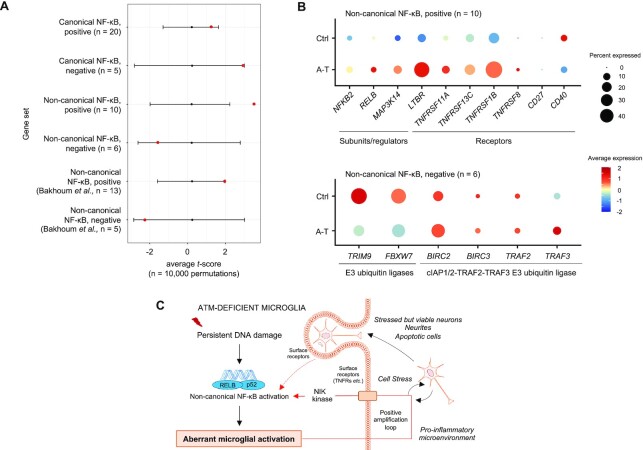Figure 7.
Non-canonical NF-κB signalling is upregulated in cerebellar microglia of individuals with A–T. (A) Average t-scores for canonical and non-canonical NF-κB gene sets from differential gene expression analyses of A–T versus control (Ctrl) cerebellar microglia. Black bars represent the null distribution of gene set average t-scores (mean ± 2SD). Red points represent the observed gene set average t-scores. Positive/negative average t-scores are indicative of increased/decreased fold change in gene expression in A–T versus Ctrl. The number of genes in a dataset is indicated as n. For P-values see Supplementary Table S3. (B) Dotplots showing average expression and percent cells expressed for individual genes involved in activation (positive) and inhibition (negative) of the non-canonical NF-κB pathway in A–T versus Ctrl cerebellar microglia. Average expression is represented by the z-score calculated by centering and scaling across microglia from A–T and Ctrl in cerebellum and prefrontal cortex. (C) Proposed mechanism for the aberrant activation of microglia in the absence of ATM kinase. Persistent DNA damage and/or its consequences associated with the loss of ATM, or its kinase activity, results in activation of the RELB/p52 non-canonical NF-κB pathway. This leads to microglial activation characterized by increased expression of pro-inflammatory cytokines and enhanced phagocytic clearance properties. The release of interleukins, chemokines, and reactive oxidative species in the extracellular compartment could promote and amplify sustained non-canonical NF-κB activation via, for example, TNFR-family CD40, LTβR or TNFR2 receptors and via NIK kinase-dependent signalling (arrows in red). Cell-intrinsic effects of ATM loss together with chronic inflammation could lead to aberrant phagocytic uptake of stressed but viable neurons and neurites. The engulfment of neuronal material could provide a secondary positive feedback loop to the non-canonical NF-κB signalling, thus contributing to progressive neuronal damage in A–T. Positive feedback loops are shown in red arrows. Dashed arrows indicate unestablished connections. The image was created using Motifolio illustration toolkits.

